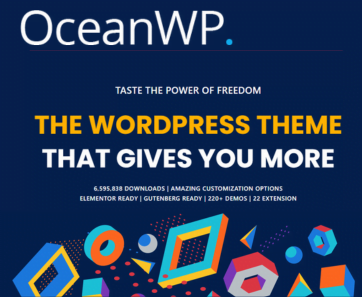39 min read
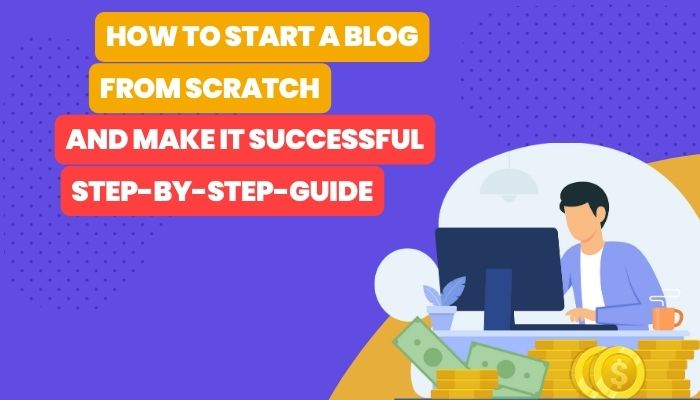
”How to Start a Blog from Scratch in 2023”
” How to make money blogging in 2023”
”How to start a blog in 2023”
”How to start a successful blog in 2023”
”How to start a blog from scratch and make it successful”
These are the most familiar search topics now. Starting a blog is not so easy. Anyone who wants to start a blog from scratch and eventually make it affluent, should follow this step-by-step guide without any hesitation.
This complete guide is divided into three parts. Part 1 will cover the most important steps at-a-glance of How to start a blog from scratch and make it successful to make money. The second part will contain the detailed description of those steps and as a bonus part, the third and last part will contain the necessary and effective tools & plugins, resources for further learning to start a blog from scratch that makes money.
Let’s start to explore the exclusive guide.
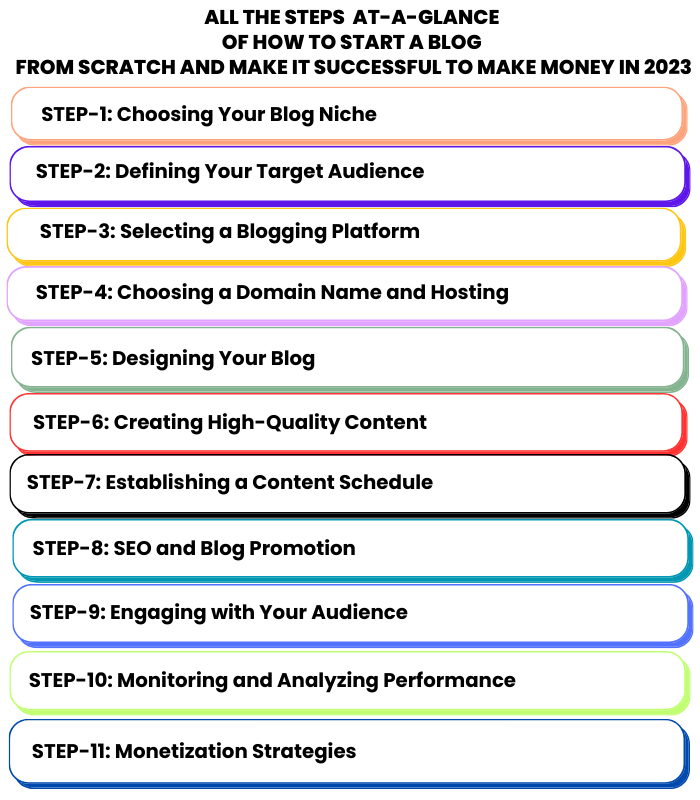
You should consistently follow these 11 significant steps if you want to start a blog and make your blog successful.
Now it’s high time to emphasize the second part of the guide, which is the detailed description of the step-by-step guide.
Introduction
In today’s digital age, blogging has evolved into a powerful tool that allows individuals to share their thoughts, expertise, and creativity with a global audience. The act of blogging enables you to communicate your ideas, insights, and experiences in a format that’s accessible to people from all walks of life. It’s a platform where your words can have a lasting impact, influencing opinions, sparking discussions, and even driving change.
Moreover, blogging goes beyond just personal expression. It has become a vital medium for businesses, influencers, and professionals to establish themselves as thought leaders in their respective fields. As a blogger, you have the opportunity to contribute to conversations, offer solutions, and provide valuable information to those seeking guidance. In doing so, you can build a loyal following, gain recognition, and establish your online presence as a credible source of information.
Starting a blog from scratch offers a plethora of benefits that can profoundly impact your personal and professional life:
- Creative Outlet: Blogging provides a creative canvas where you can express your thoughts, passions, and interests in a unique and engaging manner. It’s a space where your imagination can run free, and you can explore various writing styles, multimedia elements, and design choices.
- Personal Growth: Blogging involves researching, learning, and organizing your ideas effectively. This process enhances your critical thinking skills, writing abilities, and research capabilities, contributing to your personal growth and intellectual development.
- Building an Online Presence: In today’s interconnected world, having an online presence is crucial. A blog allows you to establish your digital footprint, making it easier for people to find you, connect with you, and recognize your expertise.
- Networking Opportunities: As you engage with your audience and connect with fellow bloggers, you’ll expand your network. This network can lead to collaborations, partnerships, and new friendships with like-minded individuals.
- Monetization Potential: While not the primary goal for everyone, a successful blog can become a source of income. Through various monetization strategies like affiliate marketing, sponsored content, and selling digital products, you can turn your passion into a revenue stream.
- Learning About Your Audience: Blogging provides insights into your readers’ preferences, concerns, and interests. This understanding can help you tailor your content to better serve your audience, fostering stronger connections.
- Impact and Influence: Your blog has the potential to influence opinions, spark discussions, and even bring about change. By addressing important topics and sharing unique perspectives, you can contribute positively to online discourse.
- Enhancing Your Brand: If you’re a business owner, professional, or freelancer, a blog can be a powerful tool for showcasing your expertise, attracting clients, and establishing yourself as a credible authority in your industry.
In the 2nd part of this comprehensive guide, I’ll describe in detail as to ‘How to Start a Blog from Scratch and Make It Successful’, equip you with the knowledge and tools you need to embark on this exciting journey of self-expression, growth, and opportunity.
Choosing Your Blog Niche
It is the 1st step of this special guide on How to Start a Blog from Scratch and Make It Successful. As a beginner, to choose the right niche you should consider 4 things as follows:
- Interest
- Passion
- Skill/Expertise
- Earning Potential/Profitability
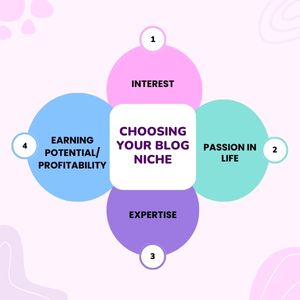
Selecting the right niche for your blog is a critical first step. Start by considering your passions, interests, and areas of expertise. What topics genuinely excite you and keep you engaged? Reflect on your hobbies, skills, and the subjects you naturally gravitate toward. Blogging about something you’re genuinely passionate about ensures that your enthusiasm shines through in your content, making it more compelling for your readers.
Your expertise also plays a vital role. Consider what you’re knowledgeable about, whether it’s from your professional background, education, or personal experiences. Demonstrating expertise in your chosen niche establishes your credibility and helps you provide valuable insights to your audience.
While following your passions is important, it’s also wise to research the profitability and sustainability of different niches. Some niches might have a more dedicated and engaged audience, making it easier to grow your readership. Research niches that have a substantial demand and a growing audience, but also ensure that they align with your interests.
Conduct keyword research using tools like Google Keyword Planner or SEMrush to identify popular topics and search trends within potential niches. Look for niches with a balance between search volume and competition. Additionally, examine whether the niche has the potential for diverse content topics, as this will allow you to continually generate engaging posts.
Striking a balance between your personal interests and audience demand is crucial. While it’s essential to choose a niche that resonates with you, it’s equally important to consider what your target audience is looking for. Your blog’s success depends on your ability to address the needs and interests of your readers.
Consider the following steps to achieve this balance:
- Audience Persona: Create detailed personas of your target audience. Understand their demographics, preferences, pain points, and aspirations. This will help you tailor your content to their needs.
- Content Intersection: Identify the overlap between your passions/expertise and what your audience is searching for. Look for areas where your interests align with topics that have a significant demand.
- Uniqueness: Identify what unique perspective or value you can bring to your chosen niche. This will set you apart from other bloggers and attract readers who resonate with your approach.
- Adaptation: Be open to adjusting your content strategy based on audience feedback and evolving trends. Flexibility ensures that you remain relevant and continue to meet your audience’s expectations.
By selecting a niche that balances your personal interests with audience demand, you’re more likely to create content that resonates, attracts a loyal readership, and sets the foundation for a successful and sustainable blog. Remember, your blog is a reflection of you, but its success hinges on your ability to provide value to your readers.
Defining Your Target Audience
Defining your target audience is the second prerequisite and an important step of this guide- how to start a blog from scratch and make it successful to make money. Defining your target audience involves creating detailed audience personas, which are fictional representations of your ideal readers.

Audience personas help you humanize and better understand the individuals you aim to reach. To create effective personas, consider the following steps:
- Demographics: Define key demographic details such as age, gender, location, education, and occupation. These factors shape your audience’s preferences and needs.
- Interests and Hobbies: Identify the interests, hobbies, and passions that resonate with your audience. This insight enables you to create content that captures their attention.
- Challenges and Goals: Understand the challenges, pain points, and goals your audience faces. This knowledge allows you to offer relevant solutions and insights.
- Behavior and Preferences: Determine how your audience consumes content – do they prefer long articles, videos, info graphics, or podcasts? Also, consider their preferred social media platforms and communication style.
- Psycho-graphics: Delve into their attitudes, values, beliefs, and motivations. This information helps you create content that resonates on a deeper level.
A successful blog is built upon meeting the needs and preferences of your target audience. Conduct thorough research to gain insights into what matters most to them:
- Surveys and Polls: Create surveys or polls to directly ask your audience about their preferences, challenges, and interests. This data provides valuable guidance for your content strategy.
- Competitor Analysis: Study other blogs or websites targeting a similar audience. Identify the type of content they publish, the engagement they receive, and the gaps you can fill.
- Social Media Listening: Monitor social media platforms and online communities relevant to your niche. Listen to conversations, comments, and discussions to understand the topics that resonate.
- Keyword Research: Use keyword research tools to identify the phrases and topics your audience is actively searching for. This informs your content creation and helps you address their questions.
Once you’ve gained a comprehensive understanding of your target audience, it’s time to tailor your content to meet their specific needs and preferences:
- Relevant Topics: Create content that addresses the challenges, questions, and interests identified through your research. Ensure that your topics are aligned with your audience’s priorities.
- Tone and Style: Adapt your writing style, tone, and language to match the preferences of your audience. Speak in a way that resonates with them and makes your content relatable.
- Formats: Offer content in formats that your audience prefers, whether it’s written articles, visual content, videos, podcasts, or a combination. Catering to their preferred formats enhances engagement.
- Solutions and Value: Provide actionable solutions, insights, and value in each piece of content. Your goal is to help your audience overcome challenges and achieve their goals.
- Consistency: Consistently deliver content that aligns with your audience’s interests. This establishes your blog as a reliable source of information and encourages readers to return.
By understanding your target audience, creating audience personas, and tailoring your content to their needs and preferences, you position your blog as a valuable resource that resonates deeply with your readers. This approach fosters engagement, trust, and long-term loyalty, setting the stage for a successful and impactful blogging journey.
Selecting a Blogging Platform
Selection of a blogging platform is considered as one of the most significant steps of the guide named How to start a blog from scratch and make it successful to make money. Overview of Popular Blogging Platforms There are several popular blogging platforms available, each with its own features and advantages. Here’s an overview of some widely used options:
- WordPress: One of the most versatile and widely adopted platforms. It offers both WordPress.com (hosted) and WordPress.org (self-hosted) options, allowing for customization, plugins, and extensive themes.
- Blogger: A straightforward platform by Google, suitable for beginners. It’s easy to use and integrates seamlessly with other Google services.
- Wix: A user-friendly platform with drag-and-drop functionality, making it easy to design and customize your blog. Wix offers a range of templates and features.
- Medium: A platform focused on content creation and community engagement. It’s great for writers who want to focus on their content without worrying about technical aspects.
- Squarespace: Known for its beautiful templates and design-oriented approach. It’s suitable for bloggers who value aesthetics and want an all-in-one solution.
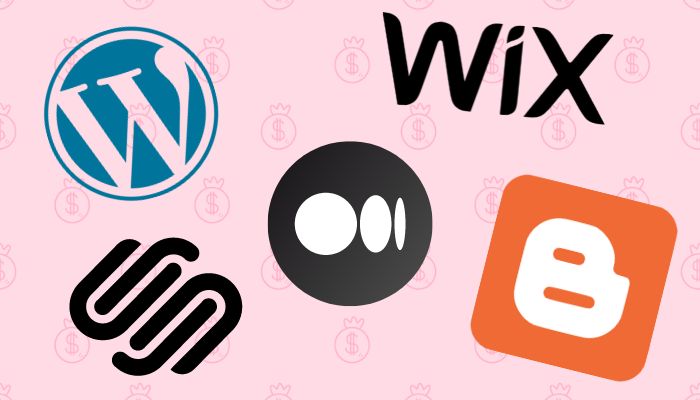
Each platform has its own strengths and drawbacks:
WordPress:
- Pros: Highly customizable, extensive plugin library, great for SEO, self-hosted option offers complete control. Moreover, according to W3 Techs, 43.1% of all websites on the internet are built on WordPress.
- Cons: Learning curve, self-hosting requires technical knowledge, potential security concerns.
Blogger:
- Pros: Simple and beginner-friendly, integrated with Google services, no hosting costs. Absolutely FREE!
- Cons: Limited customization, fewer features compared to other platforms.
WIX:
- Pros: Intuitive drag-and-drop design, built-in features, suitable for visually appealing websites.
- Cons: Limited scalability, less flexibility compared to other platforms.
Medium:
- Pros: Focus on writing, built-in audience, easy to start.
- Cons: Limited design customization, lack of full control, monetization restrictions.
Squarespace:
- Pros: Stunning templates, all-in-one solution (hosting included), user-friendly interface.
- Cons: Relatively higher pricing, less flexibility for advanced customization.
Step-by-Step Guide to Setting Up a Blog Using a Chosen Platform involves a series of steps that can vary depending on the platform you choose. Here’s a general step-by-step guide:
- Choose a Domain Name: Select a memorable and relevant domain name that represents your blog’s identity.
- Select a Hosting Plan (if applicable): If you’re using a self-hosted platform like WordPress.org, choose a hosting provider and plan that suits your needs.
- Install the Platform: Install your chosen platform on your domain. Most hosting providers offer one-click installations.
- Choose a Theme/Template: Pick a theme or template that aligns with your blog’s niche and style.
- Customize Design: Customize the design, layout, and colors to make your blog visually appealing and on-brand.
- Create Essential Pages: Create essential pages like About, Contact, and Privacy Policy.
- Install Plugins (if applicable): If using WordPress, install and configure relevant plugins to enhance functionality.
- Start Creating Content: Begin writing and publishing blog posts. Incorporate multimedia elements like images and videos.
- SEO Optimization: Optimize your content for search engines using relevant keywords, meta tags, and descriptions.
- Promote Your Blog: Share your content on social media, engage with your audience, and start building your readership.
Remember that the setup process can vary based on the platform, and each platform often provides detailed guides and tutorials to help you through the process. Choose the platform that aligns with your goals, technical comfort level, and customization needs, and follow the platform-specific steps to set up your blog effectively.
Choosing a Domain Name and Hosting
Domain Name
Your domain name is like the address of your online home, and choosing the right one is crucial for your blog’s identity and branding. Here’s why a memorable and relevant domain name matters:
- First Impressions: Your domain name is often the first thing visitors see. A memorable name makes a positive and lasting impression.
- Brand Identity: A relevant domain name reflects your blog’s niche or topic, helping visitors understand what your blog is about at a glance.
- Ease of Sharing: A short, easy-to-remember domain name is more shareable and can lead to increased word-of-mouth promotion.
- Search Ability: Including relevant keywords in your domain can improve your blog’s visibility in search engine results.
- Credibility: A professional and relevant domain name enhances your blog’s credibility and trustworthiness.
Expired Domain
A domain that has already been purchased but has not been renewed by its owner before its expiration date is said to have “expired.”
Domains are listed for a certain amount of time, usually a year, and need to be renewed to stay active. If the owner doesn’t renew the name during the grace period, it goes into a redemption period. During this time, the original owner can still get it back, but it usually costs more. As soon as the redemption time is over, anyone can register the domain based on who gets there first. People and companies that want to build an online presence can find unique opportunities in expired domains.
These domains might already have backlinks, authority with search engines, and traffic, which makes them useful for SEO tactics.
Also, you can start your new blog websites by buying expired domains, target specific businesses, or even be sold for a profit. But buying names that have already been used needs careful thought. It’s important to think about the domain’s history, its usefulness, and any legal problems that might come up.
Some defunct domains might have a bad reputation if they were used for spam or other bad/malicious things in the past. It is important for you to do research to make sure that the chosen expired domain fits with the goals and ideals of the person who will buy it.
In the end, expired domains are an interesting part of the online world because they give valuable online assets a second chance to be used and repurposed while managing the complicated world of domain ownership, history, and potential.
You can Visit: https://www.expireddomains.net/, a very familiar site to buy expired domain according to your requirements. Here, you will get almost all types of expired domains.
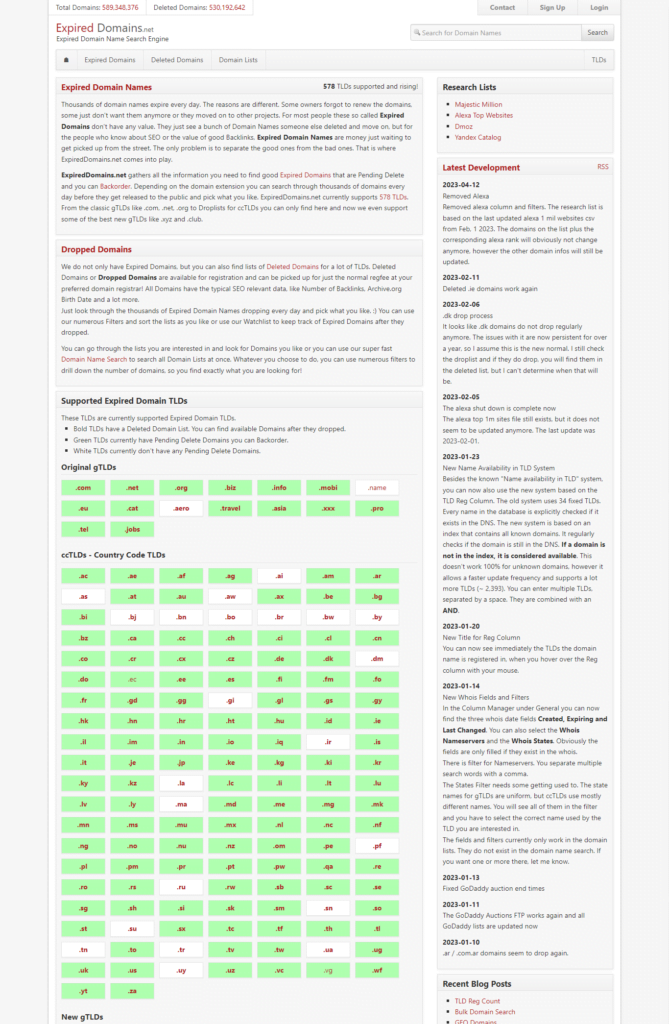
Web Hosting
Web hosting is the foundation of your blog’s online presence. It’s essential to choose a reliable hosting provider that meets your needs. Consider these factors when selecting a hosting provider:
- Uptime and Reliability: Choose a provider with high uptime guarantees to ensure your blog is accessible to visitors at all times.
- Customer Support: Opt for a host with responsive customer support to address any technical issues quickly.
- Scalability: If you plan to grow your blog, choose a hosting plan that allows you to easily upgrade as your traffic increases.
- Performance: Look for hosting that provides good loading speeds, as slow websites can discourage visitors.
- Security: A secure hosting environment is crucial to protect your blog and user data from threats.
Once you’ve decided on a domain name and hosting provider, follow these steps to register your domain and set up hosting:
Domain Registration:
- Choose a domain registrar (like Namecheap, GoDaddy, Hostinger, etc.).
- Search for your desired domain name. If available, proceed to register it.
- Provide your contact details and complete the registration process.
Setting Up Hosting:
- Choose a hosting plan that suits your needs (shared, VPS, dedicated, etc.).
- Select your preferred billing cycle (monthly, annually, etc.).
- Complete the checkout process and make the payment.
Domain and Hosting Integration:
- Update your domain’s DNS settings to point to your hosting provider’s nameservers.
- Wait for DNS propagation (typically 24-48 hours) for the domain to connect to your hosting.
Install Blogging Platform:
- If using a platform like WordPress, install it on your hosting using the provided tools.
Customize Settings:
- Configure your hosting settings, email accounts, and any security measures.
Design and Content:
- Start designing your blog and creating content using your chosen blogging platform.
Remember that many hosting providers offer step-by-step guides and customer support to assist you in the domain registration and hosting setup process. Taking the time to choose a suitable domain name and reliable hosting provider ensures that your blog starts off on the right foot, providing a stable and accessible online presence for your readers. I hope you will sincerely resolve the technical matters like choosing domain & hosting and will go a step ahead to start a blog from scratch and make it famous.
Designing Your Blog
Before starting content creation, it is mandatory to design your blog with responsive theme & effective plugins. It is an obligation to start a blog from scratch and eventually make it affluent.
Choosing a Suitable Theme or Template
The design of your blog plays a pivotal role in creating a visually appealing and engaging user experience. Choosing the right theme or template sets the tone for your blog’s aesthetic and functionality:
- Theme Selection: Browse through the theme options available on your chosen blogging platform. Consider themes that align with your blog’s niche and purpose.
- Visual Appeal: Choose a theme with a layout, color scheme, and typography that resonates with your content and target audience.
- Functionality: Evaluate the features offered by the theme, such as customizable widgets, social media integration, and navigation menus.
- Mobile Responsiveness: Ensure the theme is responsive, meaning it adapts seamlessly to various screen sizes, including smartphones and tablets.
There are many responsive & beautiful themes for WordPress. But if you ask me which is the best, I cannot tell you one name. I can tell the name of some themes; I already have used. They are Astra, Generate Press, Neve, Blocksy, Owcean WP for WordPress blog.
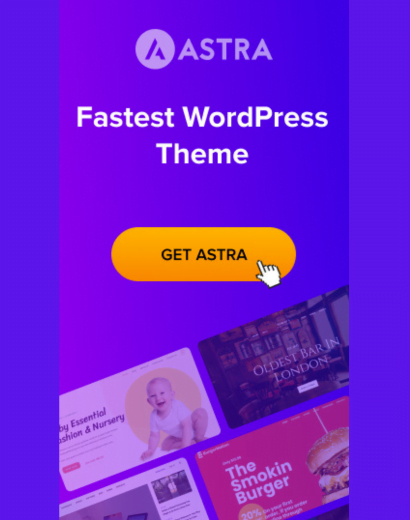
ASTRA PRO
Advanced Customization.
Extensive typography and color controls.
Seamless WooCommerce integration.
Lightning-fast performance and SEO optimization.
Custom layout options for posts and pages.
Enhanced site layout settings.
Dedicated support and regular updates.
Integration with popular page builders like Elementor and Beaver Builder.
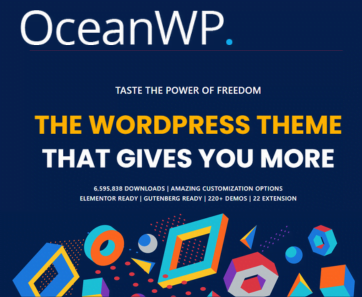
OceanWP PREMIUM
Full Customization
eCommerce Integration
Performance Optimization
SEO-Friendly & Super Responsive
Premium Extensions
Whether you are a beginner or expert, you can choose one of them. Right now, I use Astra, it is one of the most popular multi-purpose themes with 5m+ active installation. It has attractive starter templates. It is a fermium (free & premium) theme. It is fully customizable, mobile friendly, super responsive theme.
You can explore the guide on How to install and activate Astra.
Customizing the Design to Reflect Your Brand
Customization allows you to personalize your blog and make it uniquely yours. Reflecting your brand identity in the design creates a cohesive and memorable user experience:
- Logo and Branding: Incorporate your blog’s logo and color palette to establish consistent branding across your blog.
- Typography: Choose fonts that are legible and align with your brand’s style. Use fonts consistently throughout your blog.
- Header and Footer: Customize these sections to include important information, such as navigation menus, contact details, and social media links.
- Widgets and Sidebars: Utilize widgets and sidebars to display relevant content, such as recent posts, categories, and popular articles.
- Graphics and Imagery: Use high-quality images and graphics that enhance your content and resonate with your audience.
Ensuring a Responsive and User-Friendly Layout
A responsive and user-friendly layout is crucial to providing an optimal experience for all visitors, regardless of their device or screen size:
- Mobile-Friendly Design: As a significant portion of web traffic comes from mobile devices, ensure that your design looks and functions well on smartphones and tablets.
- Clear Navigation: Design an intuitive navigation menu that helps users easily find their way around your blog.
- Readability: Choose a font size and line spacing that make reading comfortable. Break up text with headings, subheadings, and bullet points.
- Whitespace: Use whitespace effectively to prevent a cluttered appearance and make your content easy to digest.
- Page Loading Speed: Optimize your images and design elements to ensure fast page loading speeds, enhancing user experience and SEO.
- User Testing: Test your blog’s design on different devices and browsers to identify any layout or responsiveness issues.
By carefully selecting a theme, customizing the design to reflect your brand, and ensuring a responsive and user-friendly layout, you create an inviting and cohesive online environment for your readers. A well-designed blog not only enhances the visual experience but also contributes to increased engagement and a positive impression of your content and brand. So please don’t underestimate the design issue of this exponential guide of how to start a blog from scratch and make it famous.
Establishing a Content Schedule
You have to establish a content schedule before content creation and publication. It is one of the vital steps of this guide of how to start a blog from scratch and make it successful to make money in 2023.
Setting Realistic Posting Frequency
Consistency in posting is important, but it’s equally crucial to set a posting frequency that aligns with your capacity and the quality of content you can produce:
- Assess Your Availability: Consider how much time you can dedicate to writing, editing, and promoting content each week.
- Quality over Quantity: Prioritize quality over quantity. It’s better to post less frequently with valuable content than to post frequently with subpar content.
- Start Small: Begin with a manageable posting frequency and gradually increase it if you find you can maintain the quality.
Consistency as a Key to Building an Audience
Consistency is a cornerstone of successful blogging. Regular posting builds trust and keeps readers engaged:
- Audience Expectations: Consistent posting sets expectations for your readers. They’ll know when to expect new content.
- Search Engine Ranking: Search engines favor blogs that consistently produce fresh and valuable content.
- Reader Engagement: Consistent posting helps maintain reader engagement, reducing the likelihood of readers losing interest.
Using Editorial Calendars to Stay Organized
Editorial calendars are valuable tools that help you plan, organize, and execute your content strategy effectively:
- Plan Ahead: Use the editorial calendar to plan content topics, keywords, and publication dates in advance.
- Diverse Content: Ensure a diverse range of topics and formats to keep your blog engaging.
- Efficiency: An editorial calendar helps streamline your content creation process, minimizing last-minute rushes.
- Content Promotion: Coordinate content promotion efforts alongside your publishing schedule.
- Flexibility: While an editorial calendar provides structure, be open to adapting it based on new trends or emerging topics.
By setting a realistic posting frequency, maintaining consistency, and using editorial calendars to stay organized, you create a blog that keeps readers engaged, builds anticipation, and demonstrates your commitment to delivering valuable content. Remember, it’s not just about the quantity of posts; it’s about maintaining a balance between consistency and content quality.
Creating High-Quality Content
You may have heard a common saying about Content and that is ‘Content is King’. So, high quality content creation is the most vital step of this guide called how to start a blog from scratch and make it successful to make money in 2023.
Planning Your Content Strategy
A well-defined content strategy is the backbone of a successful blog. It guides your efforts, ensures consistency, and resonates with your audience’s needs:
- Content Goals: Define your blog’s purpose. Are you educating, entertaining, inspiring, or solving problems for your readers?
- Audience Relevance: Tailor your content to your target audience’s interests, pain points, and aspirations identified in earlier stages.
- Content Calendar: Create an editorial calendar outlining topics, publication dates, and promotion strategies. This ensures consistent posting.
- Keyword Research: Identify relevant keywords to optimize your content for search engines and attract organic traffic.
- Diverse Topics: Offer a mix of evergreen content (timeless topics) and timely content (current trends or events) to keep your blog relevant.
Crafting Engaging and Valuable Blog Posts
The heart of your blog lies in the content you produce. Crafting high-quality, engaging, and valuable blog posts is essential for reader satisfaction and loyalty:
- Compelling Introductions: Hook readers with a captivating introduction that grabs their attention and sets the tone for the rest of the post.
- Structured Content: Organize your content with clear headings, subheadings, and paragraphs to improve readability.
- Actionable Insights: Provide practical advice, solutions, or actionable takeaways that readers can apply to their own lives.
- Engaging Storytelling: Incorporate personal anecdotes, real-life examples, or relatable stories to captivate your audience.
- Visual Appeal: Use images, diagrams, and charts to break up text and make your content visually appealing.
Incorporating Different Types of Content
Diversifying your content format keeps your blog fresh and caters to different learning styles and preferences:
- Articles and Blog Posts: Written articles remain a staple, allowing you to delve deep into topics and provide in-depth insights.
- Videos: Video content adds a dynamic element to your blog. You can create tutorials, interviews, vlogs, or even animations.
- Info graphics: Info graphics visually present complex information, making it easier for readers to understand and retain.
- Podcasts: If you have a knack for speaking, podcasts offer a convenient way for your audience to consume content on the go.
- Interactive Content: Quizzes, polls, and interactive widgets engage readers and encourage participation.
- Guest Posts and Interviews: Feature guest writers or conduct interviews with experts to offer diverse perspectives and valuable insights.
By planning your content strategy, crafting engaging and valuable blog posts, and incorporating various content formats, you create a rich and diverse content ecosystem that resonates with your audience, keeps them engaged, and positions your blog as a reliable source of information and inspiration.
SEO and Blog Promotion
For the enhancement of visitors and better ranking on any search engine there is no alternative to Search Engine Optimization (SEO) and Blog promotion. So, it is an unavoidable step to start a blog from scratch and make it famous.
Understanding the Basics of SEO (Keywords, Meta Tags, etc.)
SEO is crucial for making your blog discoverable and ranking well on search engines like Google, Bing. Here’s an overview of the basics:
- Keywords: Research and include relevant keywords in your content that your target audience is likely to search for. Place keywords naturally within your content, including headings and meta descriptions.
- Meta Tags: Optimize meta tags, including the meta title and meta description. These concise snippets appear on search engine results pages and should accurately reflect your content.
- Internal Linking: Link to other relevant posts within your blog to enhance user navigation and provide more value.
- External Links: Include authoritative external links to credible sources, and aim for receiving inbound links from other reputable websites.
- Alt Text: Use descriptive alt text for images to improve accessibility and provide context to search engines.
Promoting Your Blog Through Social Media
Promoting your blog on social media platforms can significantly increase your reach and engagement:
- Platform Selection: Choose the social media platforms that align with your target audience. For instance, visual content may work well on Instagram, while LinkedIn is suitable for professional content.
- Engagement: Actively engage with your audience on social media by responding to comments, sharing valuable insights, and fostering discussions.
- Visual Content: Use attention-grabbing visuals like images, infographics, and videos to enhance your social media posts.
- Consistency: Maintain a consistent posting schedule on social media to keep your audience engaged and informed.
- Hashtags: Use relevant hashtags to increase the discoverability of your posts.
Building Backlinks and Networking Within Your Niche
Backlinks from reputable websites signal to search engines that your blog is credible. Here’s how to build backlinks and network within your niche:
- Guest Posting: Contribute guest posts to other blogs in your niche, which can include a link back to your blog.
- Collaborations: Collaborate with other bloggers, influencers, or experts to co-create content or engage in joint projects
- Participate in Communities: Engage in online forums, groups, and communities related to your niche. Offer value and establish yourself as a knowledgeable member.
- Influencer Outreach: Reach out to influencers or thought leaders in your niche. Building relationships with them can lead to opportunities for cross-promotion and backlink opportunities.
- Networking Events: Attend industry events, conferences, and webinars to connect with others in your niche and expand your network.
By understanding the basics of SEO, promoting your blog through social media, and actively building backlinks and networking within your niche, you enhance your blog’s visibility, attract a larger audience, and establish your online presence within your chosen field. Effective promotion extends the reach of your valuable content and creates a sense of community around your blog.
Engaging with Your Audience
You will never get success overnight in this field. You have to increase engagement with your audience through your content to start a blog from scratch and eventually make it affluent.
Responding to Comments and Feedback
Engaging with your audience is a crucial aspect of building a community around your blog. Here’s how to effectively interact with your readers:
- Respond Promptly: Reply to comments on your blog posts in a timely manner. Acknowledge and appreciate readers for taking the time to engage.
- Encourage Discussion: Encourage readers to share their thoughts, opinions, and experiences in the comment section.
- Answer Questions: Address any questions or concerns raised by readers in a helpful and informative manner.
- Constructive Feedback: Welcome constructive criticism and feedback. Use it to improve your content and user experience.
Encouraging Reader Interaction and Discussions
Fostering a sense of community on your blog keeps readers engaged and invested in your content:
- Post Questions: End your posts with open-ended questions to encourage readers to share their viewpoints.
- Polls and Surveys: Use polls and surveys to gather opinions on various topics and involve readers in decision-making.
- Respond to Comments: Join the comment discussions and contribute your insights to further engage readers.
- Host Contests or Challenges: Organize contests, challenges, or giveaways that encourage readers to participate and share their contributions.
Incorporating User-Generated Content and Guest Posts
Involving your audience directly in your content creation process can deepen their connection to your blog:
- User-Generated Content: Feature content created by your readers, such as testimonials, stories, or artwork related to your blog’s theme.
- Guest Posts: Invite guest writers who are experts in your niche to contribute posts. This diversifies your content and brings fresh perspectives.
- Interviews: Conduct interviews with industry experts, influencers, or even your readers to provide valuable insights.
- Reader Spotlights: Highlight exceptional reader contributions, such as comments or user-generated content, in dedicated blog posts.
Engaging with your audience fosters a sense of community, loyalty, and genuine connection. Responding to comments, encouraging discussions, and incorporating user-generated content not only enhances the reader experience but also enriches your blog’s content and makes it a hub for meaningful interactions.
Monitoring and Analyzing Performance
If you want to start a blog from scratch and eventually make it affluent to make money you will have to maintain monitoring and analyzing performance of your blog through some efficient tools.
Utilizing Web Analytics Tools (Google Analytics, etc.)
Measuring the performance of your blog is essential for making informed decisions and refining your strategies. Web analytics tools, such as Google Analytics, provide valuable insights into your blog’s performance:
- Traffic Analysis: Track the number of visitors, page views, and unique visitors your blog receives over time.
- User Behavior: Analyze how visitors navigate your blog, which pages they spend the most time on, and where they exit.
- Traffic Sources: Identify where your traffic is coming from – organic search, social media, referrals, etc.
- Bounce Rate: Monitor the percentage of visitors who leave your site after viewing only one page. A high bounce rate may indicate issues with content relevance or user experience.
- Conversion Tracking: Set up goals and track conversions, such as newsletter sign-ups, downloads, or purchases.
Tracking Key Performance Indicators (Traffic, Engagement, Conversions)
Key performance indicators (KPIs) help you assess the effectiveness of your blog’s content and engagement efforts:
- Traffic: Monitor the growth of your blog’s overall traffic and track trends over time.
- Engagement: Measure engagement metrics, such as comments, shares, likes, and time spent on each page.
- Social Metrics: Analyze your blog’s performance on social media platforms, including followers, likes, shares, and click-through rates.
- Conversion Rates: Evaluate the success of your call-to-action (CTA) efforts by measuring conversion rates for specific actions.
- Bounce Rate: Keep an eye on your bounce rate to understand how engaging your content is to visitors.
Adapting Your Strategy Based on Insights
Regularly analyzing your blog’s performance data allows you to make informed decisions and refine your strategies:
- Identify Trends: Look for patterns and trends in your data. Identify which types of content, topics, or promotion methods are resonating most with your audience.
- Content Optimization: Adjust your content strategy based on which posts are generating the most engagement, traffic, and conversions.
- User Experience: Analyze user behavior data to identify any pain points in the user experience and make necessary improvements.
- SEO Improvements: Use insights to enhance your SEO strategy by targeting keywords that are driving traffic and adjusting your content to match user intent.
- Experimentation: Use A/B testing to experiment with different strategies and determine what works best for your audience.
By utilizing web analytics tools, tracking key performance indicators, and adapting your strategy based on insights, you can continuously refine your approach, create more effective content, and provide a better experience for your audience. The data-driven approach helps you make strategic decisions that lead to the growth and success of your blog.
Monetization Strategies
You know that a blog is now not just a means of sharing ideas or information, it has become an excellent source of income. So, you start a blog from scratch and make it famous to make money by using different monetization strategies.
Exploring Different Monetization Options (Ads, Affiliate Marketing, Products)
Monetizing your blog can be a rewarding endeavor, but it’s important to choose strategies that align with your audience and provide value:
- Advertisements: Display ads from ad networks such as Google AdSense to generate revenue based on clicks or impressions.
- Affiliate Marketing: Promote products or services relevant to your niche through affiliate links. You earn a commission for each sale or action generated through your referral.
- Sponsored Content: Partner with brands to create sponsored posts or reviews. Disclose sponsored content transparently to maintain trust.
- Digital Products: Create and sell digital products like e-books, online courses, templates, or downloadable resources related to your niche.
- Subscription Models: Offer premium content or exclusive access to subscribers for a recurring fee.
Balancing Monetization with Maintaining Audience Trust
Monetizing your blog must be done thoughtfully to preserve your audience’s trust and engagement:
- Transparency: Disclose any sponsored content or affiliate links clearly to maintain transparency with your audience.
- Relevance: Ensure that monetization methods align with your blog’s niche and provide value to your readers.
- Quality Control: Maintain the quality of your content, even when incorporating monetization strategies. Valuable content remains the foundation of audience trust.
- User Experience: Prioritize a positive user experience by avoiding excessive ads or intrusive pop-ups that could deter readers.
Scaling Your Blog’s Revenue Over Time
Scaling your blog’s revenue requires a combination of experimentation, optimization, and consistent effort:
- Diversification: Explore multiple monetization methods to reduce dependency on a single source of income.
- Testing and Optimization: Continuously test and optimize your monetization strategies to find what works best for your audience.
- Audience Growth: Focus on growing your audience as more readers can lead to increased engagement and revenue potential.
- Content Quality: Maintain a high standard of content quality, as engaged readers are more likely to convert on your monetization efforts.
- Long-Term View: Monetization strategies often take time to generate substantial revenue. Be patient and focus on building a sustainable income over the long term.
By exploring different monetization options, prioritizing audience trust, and gradually scaling your revenue over time, you can effectively generate income from your blog while maintaining a positive relationship with your readers. A balanced approach ensures that monetization enhances rather than hinders your blog’s value and impact.
Dealing with Challenges
Starting a blog from scratch and eventually making it gainful is not an easy task at all. It is not an overnight game. It takes take time to earn money. So, you have to be patient and to face all the challenges of this field. Never lose patience!
There are some common challenges you may face and the ways to escape from them are discussed below:
Overcoming Writer’s Block and Burnout
Writer’s block and burnout are common challenges for bloggers. Here’s how to overcome them:
- Take Breaks: Step away from writing when you feel stuck. Engaging in other activities can refresh your mind and creativity.
- Freewriting: Start writing without worrying about structure or perfection. This can help break through mental blocks.
- Change Environments: Write in different settings to stimulate your creativity. A change of scenery can provide new perspectives.
- Set Realistic Goals: Avoid overburdening yourself with excessive writing goals. Set achievable targets to prevent burnout.
Navigating Competition and Staying Unique
In a crowded blogging landscape, differentiating yourself is essential:
- Find Your Niche: Focus on a specific niche within your broader topic. Specializing makes your blog unique and attracts a dedicated audience.
- Unique Voice: Develop a distinct writing style and perspective that sets your blog apart from others.
- In-Depth Content: Produce comprehensive, in-depth content that provides unique insights and value to readers.
- Personal Stories: Incorporate personal anecdotes and experiences that only you can share.
Adapting to Algorithm Changes and Industry Trends
The digital landscape evolves rapidly, and staying current is vital:
- Stay Informed: Keep up with industry news and trends through blogs, forums, social media, and conferences.
- Diversify Traffic Sources: Relying solely on one traffic source (e.g., search engines) can be risky. Utilize social media, email marketing, and other channels.
- SEO Adaptation: Stay updated on search engine algorithm changes and adjust your SEO strategy accordingly.
- Flexibility: Be prepared to pivot your content strategy based on emerging trends or changing audience preferences.
- Continuous Learning: Invest in your skills by taking courses, attending workshops, and staying open to learning new techniques.
By finding ways to overcome writer’s block and burnout, distinguishing yourself from competitors, and staying adaptable to algorithm changes and industry trends, you can successfully navigate the challenges that come with blogging. These challenges are opportunities for growth and improvement, allowing you to create a resilient and thriving blog in the long run.
Additional Resources – Bonus Part
In the 3rd and last part of this exclusive guide, I want to share some magnificent articles on How to Start a Blog from Scratch and make it successful to Make Money. You should explore these articles sincerely from A-Z:
Neil Patel.com: ”How to Start a Blog That Makes You Money”
WIX: ”How to easily start a blog and monetize it in 2023”
Hubspot: ”How to Create a Successful Blog Strategy: A Step-by-Step Guide”
Hostinger: ”How to Start a Blog in 10 Easy Steps + Simple Blogging Best Practices for Beginners”
Ryan Robinson: ”How to Start a Blog (and Make Money) in 2023”
You can explore Free Blogging Video Tutorial from YouTube by typing; ‘How to start a blog from scratch and make it successful’
Explore the Free SEO learning center of MOZ
You can explore the following awesome Tools that I recommend to use to start a blog from scratch and eventually make it famous:
| S.L | Tools | Provider |
| 1 | Blogging Platform | WordPress |
| 2 | Domain | Go Daddy, Name Cheap, Hostinger |
| 3 | Hosting | Hostinger |
| 4 | Themes | Astra, Ocean WP, Generate Press, Blocksy |
| 5 | Plugins | Rank Math Pro, Elementor Pro, ConvertKit, Jetpack, LiteSpeed Cache, Site Kit by Google, WPForms / Contact Form 7, Kadence Blocks |
| 6 | SEO Tools | Semrush, Ahrefs, Ubersuggest (Premium), Google Keyword Planner, The Hoth Google Keyword Planner (Free) |
| 7 | Content Schedule | Publish Press |
| 8 | Content Research | Google Trends, Google Bard, Chat GPT, Semrush Topic Research Tool |
| 9 | Content Creation | Grammarly, Canva, Quilbot, Google Docs |
| 10 | Performance Monitoring Tools | Google Search Console, Google Analytics |
| 11 | Monetization Tools/Methods | Google AdSense, Ezoic and other Ad Networks, Affiliate Marketing, Selling Products |
If you use these above tools, you will surely benefit in the long run.
Most of the tools in the above list are Freemium (Free + Premium). Some are absolutely free. If you are an absolute beginner, you should subscribe to the free version. But if you’ve already started a blog and earned money from the blog, you should invest to buy the tools and undoubtedly it will be a good investment. You’ll get a good Return on Investment (ROI) in the near future.
It is important to notify you that you won’t get all the features in the free version.
Final Words
As I wrap up my guide on how to start a blog from scratch and make it successful, let me recap all the crucial steps of starting a blog from scratch and eventually make it gainful: step-1: Niche selection, step-2: Your target audience consideration, step-3: Blogging platform selection, step-4: Domain name & Hosting provider selection, step-5: Design Your blog, step-6: A content schedule maintain, step-7: Produce high-quality content, step-8: SEO and Blog Promotion, step-9: Engagement with your audience, step-10: Monitor and Analyze performance regularly, step-11: Monetize your blog using different methods.
In conclusion I want to say that I have taken blogging as a full-time career option, which is the best decision I’ve ever made. Actually, I love freedom. I always wanted an independent profession. Now I’m living a hassle-free life which I always wanted.
Honestly, I wrote this comprehensive blogging guide for those who like to work independently like me. If you want to choose blogging as a full-time career option or side hassle then follow this step-by-step guide and start your blogging journey.
Remember that earning money from blogging is neither easy nor impossible. It takes time. If you have dedication, hard work, honesty and consistency, you will definitely succeed in blogging. So, start today without delay. Believe in yourself; you too will surely succeed. Never give up! I look forward to your success. Will you start from today? Let me know your reply in the comment box.
FAQs
Q1: Can I start a blog without any technical knowledge?
Yes, many free blogging platforms, like WordPress, offer user-friendly interfaces, making it easy for beginners to start a blog without any technical expertise.
Q2: Is it possible to change my blog’s theme later?
Absolutely! You can change your blog’s theme at any time. WordPress allows you to switch between different themes effortlessly.
Q3: How long does it take to monetize a blog?
The time it takes to monetize your blog varies depending on various factors, such as niche, content quality, and promotion efforts. Some bloggers start earning within a few months, while others may take longer.
Q4: Should I focus on writing about my passions or trending topics?
It’s ideal to find a balance between your passions and trending topics. Writing about what you love will keep you motivated, while incorporating trending subjects can attract a wider audience.
Q5: Can I run multiple blogs using one hosting account?
Yes, many hosting providers allow you to host multiple blogs using one account, making it cost-effective and efficient for managing multiple websites.




